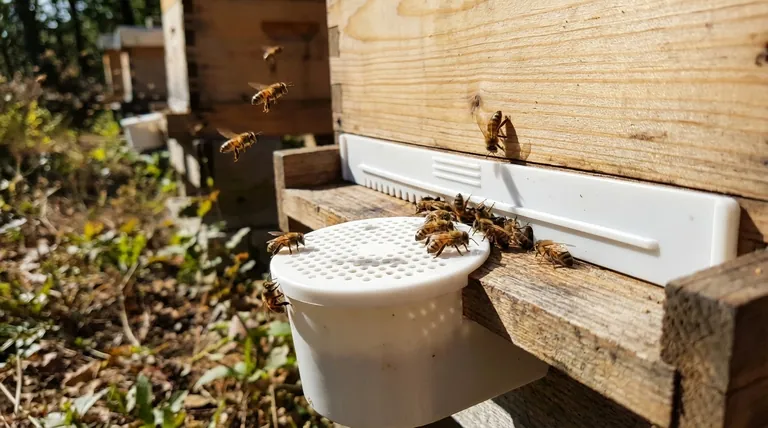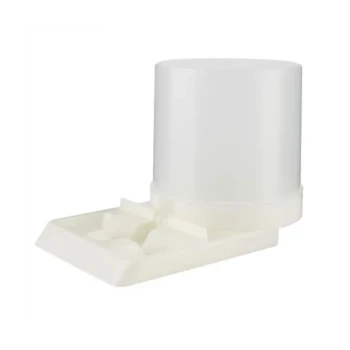The primary precaution when using an entrance feeder is to be vigilant about "robbing," a situation where bees from other colonies attack your hive to steal its food stores. Because these feeders are placed at the hive's entrance, they advertise the food source to outsiders. Therefore, they should only be used with strong colonies during warm months when natural nectar is abundant and the risk of robbing is lowest.
Entrance feeders trade hive security for beekeeper convenience. While they are easy to monitor and refill, their external placement creates a significant risk of robbing that can weaken or destroy a colony if not managed carefully.

The Core Conflict: Convenience vs. Security
Entrance feeders present a fundamental trade-off that every beekeeper must understand. Their design is both their greatest strength and their most significant weakness.
The Appeal: Undisturbed Monitoring
The main benefit of an entrance feeder is its placement outside the hive. This design consists of a feeding tray that slides into the hive entrance, connected to an external jar.
This allows you to check the syrup level at a glance and refill it without opening the hive, which minimizes disturbance and stress to the colony.
The Risk: An Open Invitation to Robbers
The very same external placement that provides convenience also acts as a beacon for robbing bees, wasps, and other insects. The scent of sugar syrup at the entrance can trigger a feeding frenzy.
Once robbing begins, it can quickly escalate into a full-scale invasion that a weaker colony cannot defend against, often resulting in the death of the queen and the collapse of the hive.
Key Precautions for Safe Entrance Feeding
If you choose to use an entrance feeder, you must do so strategically by controlling the conditions under which you feed.
Assess Your Colony's Strength
Entrance feeders should only be used on strong, populous hives. A large population of guard bees is the first and best line of defense against would-be robbers.
Never use an entrance feeder on a new, small, or weak colony, as they lack the numbers to defend their entrance effectively.
Time Your Feeding Carefully
Timing is the most critical factor. Only use entrance feeders during warm months when there is a healthy nectar flow from blooming flowers. When natural food is plentiful, other bees are less likely to resort to robbing.
Avoid feeding during a nectar dearth—a period when few plants are blooming. This is when robbing pressure is at its absolute highest, and using an entrance feeder is extremely risky.
Prevent Leaks and Spills
Ensure your feeder is designed for bees, made of food-grade plastic, and does not drip. Any spilled syrup around the hive entrance will attract ants and escalate the risk of robbing from other bees.
A properly functioning feeder should deliver the syrup directly to the bees inside the hive with no external leakage.
Consider Your Climate
Because the feeder's jar is exposed to the elements, it is not suitable for use in cold weather. The sugar syrup can easily freeze, rendering it useless to the bees when they may need it most.
Understanding the Trade-offs: When to Avoid Entrance Feeders
For an objective advisor, it's just as important to know when not to use a tool. Entrance feeders are the wrong choice in several common scenarios.
The Problem of Weak Hives
A weak hive is a target. Using an entrance feeder on one is like putting a "free food" sign on the front door of a house with no one home to guard it. It makes a vulnerable situation worse.
The Danger of Nectar Dearth
During a dearth, foraging bees are desperate for a food source. The scent of an entrance feeder can incite a robbing frenzy from multiple nearby hives, overwhelming even a reasonably strong colony.
The Ineffectiveness in Cold Weather
Entrance feeders are strictly a warm-weather tool. Their susceptibility to freezing makes them an unreliable and inappropriate choice for fall or winter feeding.
The Alternative: Internal Feeders
In almost all high-risk situations (weak colonies, nectar dearths, cool weather), an internal feeder is a safer choice. Top feeders or frame feeders, placed inside the hive, are far less likely to encourage robbing because the scent is contained within the hive.
Making the Right Choice for Your Goal
Your decision should be based on a clear-eyed assessment of your colony's health and the current environmental conditions.
- If your primary focus is convenience for a very strong hive during peak season: An entrance feeder can be a viable, low-effort option, provided you monitor for robbing activity.
- If your primary focus is supporting a new, small, or weak colony: Do not use an entrance feeder. Opt for a more secure internal feeder to avoid putting the colony at risk.
- If your primary focus is feeding during a nectar dearth or in cooler weather: An entrance feeder is the wrong tool for the job. Use an internal feeder to protect your hive.
Ultimately, successful beekeeping relies on making decisions that prioritize the long-term health and security of your colony.
Summary Table:
| Precaution | Key Action | Why It Matters |
|---|---|---|
| Assess Colony Strength | Use only on strong, populous hives | Strong colonies have enough guard bees to defend the entrance |
| Time Feeding Correctly | Feed during warm months with active nectar flow | Reduces robbing pressure when natural food is available |
| Prevent Leaks & Spills | Ensure feeder is drip-free and food-grade | Spilled syrup attracts robbers and other pests |
| Consider Climate | Avoid use in cold weather | Prevents syrup from freezing and becoming inaccessible |
| Monitor for Robbing | Watch for aggressive bee behavior at entrance | Early detection allows for quick intervention |
Ready to upgrade your feeding strategy? At HONESTBEE, we supply commercial apiaries and beekeeping equipment distributors with reliable, bee-safe feeding solutions designed for optimal hive security. Our wholesale-focused operations ensure you get professional-grade equipment at competitive prices.
Let us help you protect your investment - Contact our expert team today to discuss the right feeding equipment for your specific operation and climate conditions.
Visual Guide

Related Products
- Classic Boardman Entrance Bee Feeder Hive Front Feeding Solution
- HONESTBEE Entrance Bee Feeder Professional Hive Nutrition Solution for Beekeeping
- Professional Hive Front Entrance Bee Feeder
- Boardman Entrance Bee Feeder Durable Galvanized Steel and Wood Construction for Beekeeping
- HONESTBEE Entrance Bee Feeder Efficient Hive Front Liquid Feeding Solution for Beekeeping
People Also Ask
- How to make an entrance feeder for bees? A DIY Guide for Safe & Effective Feeding
- How is the mesh ladder and barrier installed in the feeder box? A Step-by-Step Guide to Prevent Bee Drowning
- Should bees be fed after installing a nucleus hive? Ensure Your New Colony Thrives
- What is a common problem with hive front feeders? Avoid Robbing Frenzies and Protect Your Hives
- What types of bee feeders are available for beginners? Start with the Simple Entrance Feeder



















